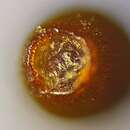Comments
provided by eFloras
Weissia brachycarpa is a new name for the illegitimate combination
Weissia microstoma (Hedwig) Müller Hal.
Weissia brachycarpa is easily distinguishable from related Weissia by the mostly plane (not tightly inrolled) distal leaf margins and usually a rather large mucro, composed of ca. 10 clear cells, but often only of 4-6 cells; other Weissia species have mucros of about six cells. Often the distal margins are sharply incurved (a sharp inflexion seen in section) and although the gametophyte has the appearance otherwise of Trichostomum crispulum, the largely plane (or broadly incurved) distal margins may be taken as a secondary character, perhaps a reduction. Weissia ludoviciana, likewise, has largely plane distal leaf margins, but inflexion may be evident in some specimens. In addition, the very long and narrow leaves of W. brachycarpa and W. ludoviciana are not duplicated in Trichostomum except in the T. tenuirostre complex. Weissia brachycarpa is cladautoicous, with perigonial buds borne in the axils of lower branches of robust fruiting plants. Weissia brachycarpa is related to W. rutilans of the Old World by the nearly identical gametophytes; the latter species differs in the rudimentary peristome teeth, and slightly larger spores. The nomenclature of W. brachycarpa is intricate; see discussions by M. O. Hill (1981) and T. J. Koponen et al. (1977).
- license
- cc-by-nc-sa-3.0
- copyright
- Missouri Botanical Garden, 4344 Shaw Boulevard, St. Louis, MO, 63110 USA
Description
provided by eFloras
Leaves lanceolate to long-lanceolate, base weakly differ-entiated to elliptic, shoulders weak or absent, distal laminal margins very broadly incurved to erect, apex broadly channeled, acute, mucro usually very strong, of 5-7(-10) cells; costal adaxial stereid band smaller than the abaxial; distal laminal cells 8-12 µm wide. Sexual condition cladautoicous. Seta elongate, (0.2-)0.28-0.4 cm. Capsule stegocarpic, ovoid, often slightly curved or bulging on one side, operculum differentiated, falling, peristome absent.
- license
- cc-by-nc-sa-3.0
- copyright
- Missouri Botanical Garden, 4344 Shaw Boulevard, St. Louis, MO, 63110 USA
Description
provided by eFloras
Plants small, 2–4 mm high, in dense tufts. Stems erect, simple, densely foliate. Leaves often crowded at stem tips, crisped when dry, spreading when moist, lanceolate, somewhat broad, slightly sheathing at base, upper lamina often channeled, gradually acuminate at apex; margins strongly incurved above the leaf base, entire or crenulate by projecting papillae; costa rather stout, percurrent; upper leaf cells small, rounded hexagonal, evenly thick-walled, densely papillose; basal cells sharply differentiated, rectangular, smooth. Dioicous. Setae 4–6 mm long; capsules slightly inclined, oblong-ovoid, the mouth of the capsules narrowed, closed by an imperfect membrane; peristome none; opercula conic-rostrate, with an oblique beak.
- license
- cc-by-nc-sa-3.0
- copyright
- Missouri Botanical Garden, 4344 Shaw Boulevard, St. Louis, MO, 63110 USA
Distribution
provided by eFloras
Distribution: China, widespread in Asia, Russia, Europe, northern Africa, and North America.
- license
- cc-by-nc-sa-3.0
- copyright
- Missouri Botanical Garden, 4344 Shaw Boulevard, St. Louis, MO, 63110 USA
Habitat
provided by eFloras
Habitat: on rocks in shade or thin soil over rocks.
- license
- cc-by-nc-sa-3.0
- copyright
- Missouri Botanical Garden, 4344 Shaw Boulevard, St. Louis, MO, 63110 USA
Synonym
provided by eFloras
Hymenostomum brachycarpum Nees & Hornschuch in C. G. D. Nees et al., Bryol. Germ. 1: 196, plate 12, fig. 3. 1823; H. microstomum (Hedwig) R. Brown; H. microstomum var. brachycarpum (Nees & Hornschuch) Huebener
- license
- cc-by-nc-sa-3.0
- copyright
- Missouri Botanical Garden, 4344 Shaw Boulevard, St. Louis, MO, 63110 USA
Synonym
provided by eFloras
Weissia microstoma (Hedw.) C. Müll., Syn. Musc. Frond. 1: 660. 1849, hom. illeg. Gymnostomum microstomum Hedw., Sp. Musc. Frond. 33. 1801. Type. Europe. Weissia hedwigii C. Crum, Bryologist 74: 169. 1971. Hymenostomum microstomum (Hedw.) R. Brown. in Nees & Hornsch., Bryol. Germ. 1: 196. 1823.
- license
- cc-by-nc-sa-3.0
- copyright
- Missouri Botanical Garden, 4344 Shaw Boulevard, St. Louis, MO, 63110 USA

